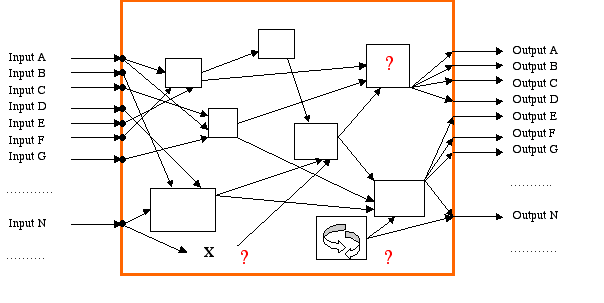Serendip is an independent site partnering with faculty at multiple colleges and universities around the world. Happy exploring!
Bio 202, spring 2010 - Notes

|
19 January
Where is neurobiology and behavior going? A challenge?
- Scientists find a shared gene in dogs with compulsive behavior, NYTimes, 18 Jan 2010
- Mental health: deficiencies in treatment of depression, NYTimes, 8 Jan 2010
- The Americanization of mental illness, NYTimes, 8 Jan 2010
- The out of sight mind, NYTimes, 14 Jan 2010
"The more scientists look, the more they're able to tease romance apart into its individual strands--the visual, auditory, olfactory, tactile, neurochemical processes that make it possible."
Jeffrey Kluger, "Why We Love", Time Magazine, 17 January, 2008
"Moral intuitions ... are being explained with tools from game theory, neuroscience, and evolutionary biology"Steven Pinker, "The Moral Instinct", NYTimes Magazine, 13 January 2008
"if time doesn't exist, why do we experience it so relentlessly? Is it all an illusion?"The response in general
Assemble a team of people with different backgrounds/perspectives to look into what is emerging from scientific exploration, become familiar with it and its implications, become involved directly and/or by helping others understand/become involved
|
Everyone has expertise, in their own distinctive and hence valuable forms. (See Evolving humanity: towards a third way?) |
- What distinctive experiences/characteristics do you bring to the conversation this semester?
- What do you think are the most important questions to be addressed by research in neurobiology and behavior in the near future?
The challenge more concretely
Neurobiology and BEHAVIOR ... what is "behavior"?
| Everything we can observe another organism/person doing from outside them, together with everthing we think we need to imagine going on inside them to account for what we observe from outside (emotions, drives, creativity, consciousness, agency, rationality, self?) |
NEUROBIOLOGY and behavior ... Neurobiology = study of the nervous system ... what is the "nervous system"?
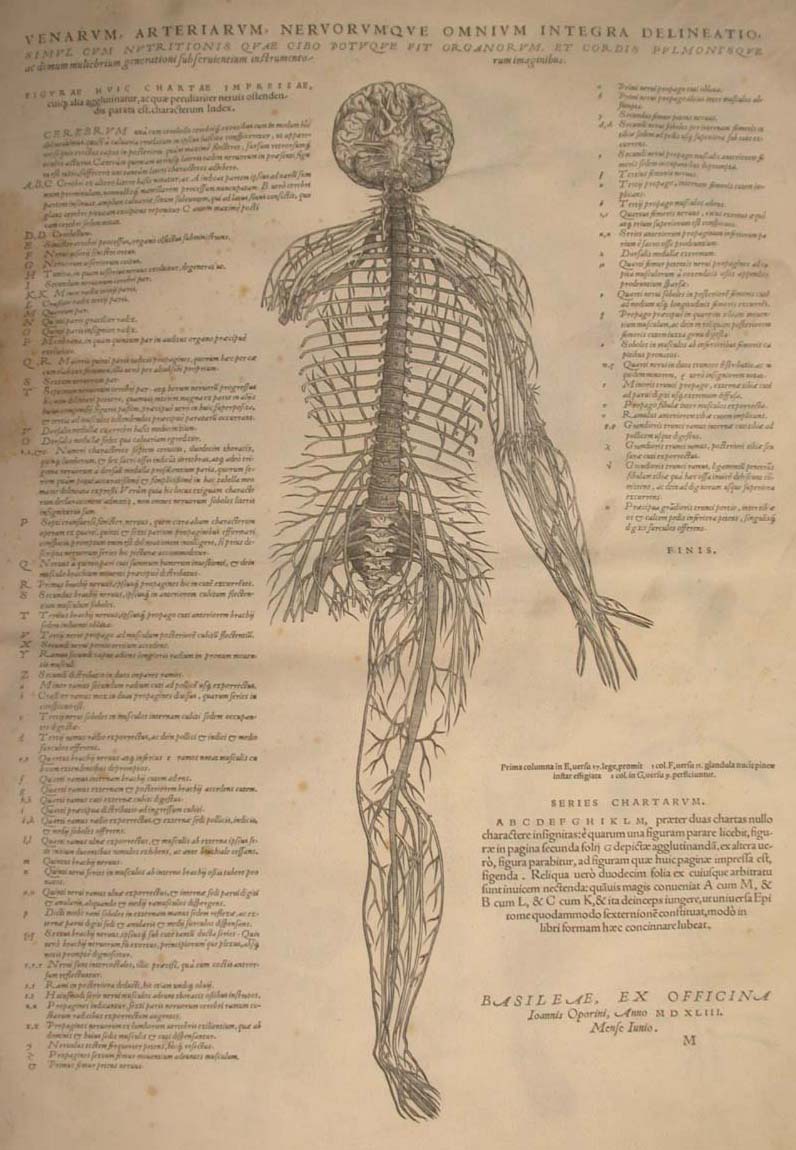 |
Image by Andreas Vesalius (1514-1564), contemporary of Copernicus, suggested (less than 500 years ago) that nervous system rather than heart was origin of behavior (see Milestones in Neuroscience Research for a time line extending from 4,000 B.C.). | 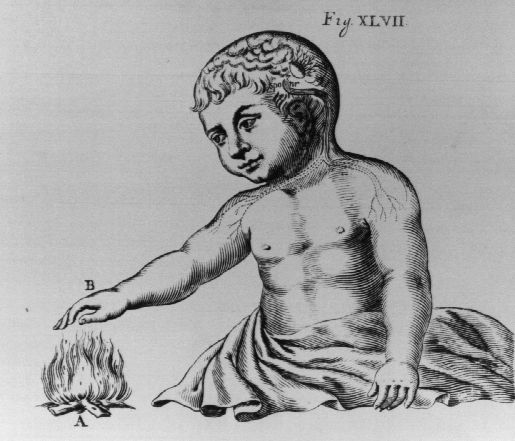 |
Image by Rene Descartes (1596-1650). Set framework for several centuries (and continuing) discussion: mind and body distinct things or same thing? |
| Nervous system is material object, part of body, can be touched, manipulated, measured. What IS the relationship between brain (nervous system) and behavior (broadly defined to include human experience)? Subset of this are questions such as the relation between mind and brain, mind and body, matter and spirit, matter and form ... | |||
The core of the challenge
- Emily Dickinson (1830-1886)
- Francis Crick, 1995: The Astonishing Hypothesis: "a person's mental activities are entirely due to the behavior of nerve cells ... and the atoms, ions, and molecules that make them up and influence them".
- V.S.Ramachandran, 2003: " it never ceases to amaze me that all the richness of our mental life - all our feelings, our emotions, our thoughts, our ambitions, our love life, our religious sentiments and even what each of us regards as his own intimate private self - is simply the activity of these little specks of jelly in your head, in your brain. There is nothing else"
- Paul Grobstein, contemporary: "Brain = behavior, there isn't anything else."
- Descartes (among others) was ... wrong? We are actually nothing more, and nothing less, than organized clumps of matter? From which it follows that ... ?
From the forum ...
Brain = behavior?
brings to light so many similarities in our species that, if every widely accepted, could really change how humans see the world and how we conduct their lives ... Emma Wipperman
can the brain be its own stimulus? ... gloudon
Everything is a construction of the brain?
Did the color blue exist before human eyes were there to see it? Such intriguing questions quickly lead down a slippery slope, disintegrating the world as we know it. ... Lauren McD
The world and the objects, organisms and the plethora of potential ideas we form with regards to these would be nothing if we were unable to define, identify, and interpret them ... On the other hand, if a tree falls and no one is there to hear it, does it make a sound? ... natmackow
if we can put those feelings aside and think about the sky objectively, we can observe, describe and even quantify it with reliable consistency. That is, so many people think and feel similarly about the sky. It seems unlikely that such standardized observations could be made if people are as unique and different from one another as we want to believe ... Does it mean the universe as we know it will cease to be if humans go extinct or evolve some new mental capacity? Since animals (supposedly) do not think the same way humans do, do they exist in separate universes? What about inanimate objects or organisms that don’t think at all? ... kdilliplan
According to Hinduism, we are born to suffer and pay for the sins of our past lives. Once we have paid for these sins, we attain moksha or freedom from rebirth or freedom from being attached to a physical form; we become part of the universal soul. ... rkirolskar
I guess I'm struggling because I consider the "it's all brain" argument to also mean there is no spirituality, but perhaps spirituality is merely a construction. .... Schmeltz
this leads to another question: what about the brain itself? ... Congwen Wang
the idea that the world as experienced by humans is a construct of the brain doesn’t contradict the idea that an external reality exists as well ... aeraeber
Science
In terms of the adjectives of the word “science” we were to come up with during class, it was amusing to see the different words students would use to describe science. I also thought that the word “limited” was very interesting to use like ifrontino because personally I hadn’t seen science as limited ... Saba Ashraf
The only thing that bothers me with these approaches to science is that there is a great lack of certainty ... we can only do our best to understand and come to terms with it. It is that very fact that I find the most exciting ... Jeanette Bates
Maybe it's not that science isn't 'objective'—it's that the very idea of objectivity is problematic ... smkaplan
Brain = behavior?, from a "scientific" approach; could science too be a "construction"?
The Nature of Science: Strengths, limitations, and potentials of empirical knowledge
Science as Story Telling and Story Revision
(article, web resources, on-line forum)
Relevant both as context for course and as introduction to fundamental feature of brain, "loopiness"
| Linear science | Seriously loopy science |
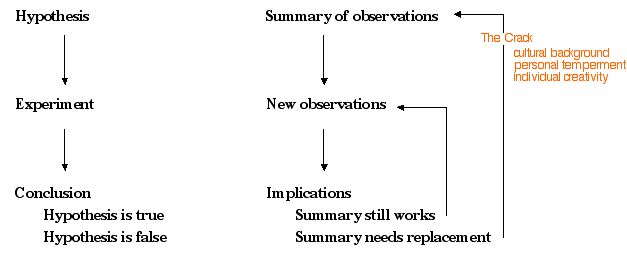 |
|
| Science as body of facts established by specialized fact-generating people and process
Science as successive approximations to Truth
|
Science as ongoing process of getting it less wrong, potentially usable by and contributed to by everyone
Science as ongoing making of observations, intepreting/summarizing, making new observations, making new summaries Science as process of inquiry into anything, one which everybody is equiped to do/can get better at/be further empowered by, and contribute to - a way of making sense of what is but even more of exploring what might yet be |
|
| If science is as much about creation as discovery then the "crack"is a feature, not a bug ... and differences among people are an asset to the process rather than a problem or an indication it isn't working |
"I wish mental differences weren't so stigmatized. They are more common than you think, and I wish people didn't have to be scared of sharing their own experiences, because if they did share, they would likely discover that they are not alone" ... and perhaps that our differences are in fact valuable to ourselves and others? See neurodiversity and the default and reading/music abilities/"disabilities" |
- Revisiting Science in Culture: Science as Story Telling and Story Revision
- Getting It Less Wrong, The Brain's Way: Science, Pragmatism, and Multiplism
- Thinking About Science: Evolving Stories
- Science as Story Telling in Action
- Science as Storytelling or Story Telling? A Conversation About Science Education ... and Science
- Paths to Story Telling as Life: Fellow Travelling with Richard Rorty
- Making Sense of Understanding: The Three Doors of Serendip
Trying It Out
Which of the following two stories do you prefer?- The earth is flat (Flat Earth Society)
- The earth is round
- personal observations?
- observations made by others (personally verified or not)?
- social stories (heard from others)?
- usefulness?
Which of the following two stories do you prefer? Because of ...
- personal observations?
- observations made by others (personally verified or not)?
- social stories (heard from others)?
- usefulness?
- is one or the other story "true"? are there others?
Scientific stories are frequently efforts to summarize the widest possible range of observations, always motivate new observations and hence new stories, should never be understood as "authoritative" or "believed in", do not compete with or invalidate other stories. Key issues about scientific stories
|
Which story do you prefer about brain and behavior?
| Descartes et al: There is brain and mind (or soul or ...) | 13 |
| Dickinson et al: Its all brain/neurons/matter ... | 14 |
| Unsure/fence-sitting/other | 3 |
Issue in loopy science is not "Truth" but whether something is a good "summary of observations", "working hypothesis", something that contributes to getting it continually "less wrong," is useful for the ongoing generation of new stories in science and in culture at large ...
Which do you think is a better "scientific" story?
| Descartes et al: There is brain and mind (or soul or ...) | |
| Dickinson et al: Its all brain/neurons/matter ... | |
| Unsure/fence-sitting/other |
Our task for the semester (and beyond?):
to try and make sense of an existing and continuing explosion of observations on the brain, observations that have the potential to greatly influence our sense of ourselves and our relation to the world.... and to help others make sense of it as well.
Your starting thoughts about "brain=behavior", about science as story? about loopiness? ... are they good summary of observations? stories? What observations do they not incorporate? What new questions do they raise?
Start with overview of the "trend of the evidence":
- Behavior can be altered by altering the nervous system
- Traumatic brain damage
- Surgery, drugs, and ... ?
- Epilepsy as an instance
- Lots of aspects have behavior, even quite sophisticated ones, have "material" feel about them
- Surprising and quite sophisticated things can emerge from interactions of simple elements (of which the brain/nervous system is an example, as we'll see).
- It isn't that anything "disappears" as one discovers things related to the brain but rather that the Brain gets "wider"
- Disadvantages?
- Advantages:
- ???
- would make the unobservable observable?
- Brain=behavior "True"? ("perhaps we just do not have the right microscopes yet"?). Good "story"?
From the forum ...
Loopy science?
As a Chemistry major, I was surprised that I accepted the idea of "loopy" science so easily. When I mentioned the idea of loopy science to my roommate who is also a chemistry major she did not accept the idea at all and was rather concerned about it. Her major concern was that if science can't establish any "truth" then what exactly are we taught in all our chemistry courses? Were they all lies then? I think that the "truths" we are currently being taught are merely just the current observations/research of the last ten years or so that have been weaved into basic guidelines and presented in textbooks ... cchen
what I find most interesting is that while the “hard” sciences may be increasingly looked at from the loopy science framework, it seems like the social sciences, like anthropology, are still trying to emulate the “hard” sciences by trying to fit into the linear science model ... So what happens when the loopy science model does become the model that is presented to 1st graders in their science classes? Will anthropology realize that maybe they did have it right all along? ... molivares
I feel like my generation is losing that inquiry instinct because we've been taught science and math in a very structured and closed fashion ... Schmeltz
As science is aimed at furthering human understanding, perhaps it is necessary that it be “tainted” with a human element at its core ... Andy Mittelman
I always just thought science was something cool, it was about learning new things and possibly shedding new light and new theories on old subjects ... dvergara
If the truth cannot be established, then these statements are to be questioned, which means it is still possible that there is the “universal truth”. My personal opinion is that science may not reveal the truth does not necessarily mean the truth does not exist. When we say something is “less wrong” than the other, we can also say it is “more right”, otherwise there would be no right or wrong in the first place ... Congwen Wang
Science deals with the material world, and not the immaterial ... Kwarlizzie
I don’t think there always has to be something complicated behind simple rules for “simple things interacting in simple ways.” Certainly complicated things like the human brain are capable of creating systems with simple rules, but such interactions can occur without human involvement as well. Life has changed and evolved based on novel and complicated results of simple interactions, molecules interacting to form proteins, cells interacting to form tissues and organs, and so forth. Certainly there are people who would say that life is the result of a complicated force, of intelligent design, but I am not one of them. Any set of simple rules can create surprising, complex outcomes; intelligence isn’t needed to find the “right” set of simple rules ... araeber
A loopy classroom?
![]() It's hard to talk about anything when we don't define our terms ... should we not have the starting point of knowing, at the very least, whether we are talking about (for instance) our physical universe in which we all live and breathe --- or the universes we have constructed in our minds? If terms like this were clearer, wouldn't our answers be, too? Shouldn't we start from the same place -- grounded in common definitions of the terms we are using -- in order to understand each other more fully, and use time more efficiently? ... egleichman
It's hard to talk about anything when we don't define our terms ... should we not have the starting point of knowing, at the very least, whether we are talking about (for instance) our physical universe in which we all live and breathe --- or the universes we have constructed in our minds? If terms like this were clearer, wouldn't our answers be, too? Shouldn't we start from the same place -- grounded in common definitions of the terms we are using -- in order to understand each other more fully, and use time more efficiently? ... egleichman
I agree with Eve's comment: we need to define our terms ... Our discussion topics are focused on everyday words like 'brain,' 'mind,' and 'universe,' but from class, I could tell that everyone else's definitions differed from mine ... Emma Whipperman
I find it strange that we use our brains to question the way the brain works, it seems counterproductive ... Raven
Descartians and Dickensians
If we think of our brains as the physical matter, then why/how are we different from one another? ... Raven
it is a lot more comforting to believe in a soul living after death than a physical body after death ... Ashraf
if we really are only made of matter, we have the same ultimate fate as everything else on Earth ... it is natural to want to find comfort in ... an afterlife, a higher power, or a significant purpose in our lives ... Lauren McD (see also gloudon)
It is the mind and spirit that makes us question and explore, brings out our passions ... mcurrie
To think that the brain and its chemical reactions solely control my being makes me feel like I have no personal control over myself ... MEL
It would be disheartening if it was all brain because it would be accepting that one cannot control thoughts and actions ... Schmeltz
if the brain is all that we are, if it completely constructs our reality, then it leaves little room for morals ... if there isn’t another force determining our behavior besides the brain, it is hard to argue for the idea of free will ... Jeannette Bates
Can I operate as I always have, knowing that my selfhood may be secondary to the gook in my brain, with my only solace being that it is special gook: My Gook? ... Hanna Silverblank
I do not want to be a body and a mind. Those dissociative moments terrify me and make me feel less real, less in my skin. I know it sounds like I should be embracing Descartes idea because of these experiences-- that I seem to observe the separation between the material and immaterial. But that's not how I feel. I like being a whole, entirely physical being. I find the idea comforting; it's what pulls me back into me ... kgould
The idea of there being an immaterial part of me actually makes me feel less comfortable and less connected with the universe ... Riki
Physically, organisms are matter that make up the body (brain, neurons, chemical interactions), but it seems to me that these material functions are but a foundation for a “spirit” that takes the material to a whole new level ... Collette
In doing this activity, I learned more about myself and my own tendency to defend my own ideas quite blindly rather than consider a possible other side to the story or think of a compromise. If I look at both explanations from a completely honest point of view, I would say I favor a combination of both ideas. Our brain and nervous system make up who we are. Different combinations of neurons and chemicals must make up for alterations in personality. However, I still can't shake the feeling that humans have a so-called 'soul.' Therefore it is quite logical for me to decide to adopt a combination of both the Descartes and Dickinson theory ... lfrontino
Moving on ...
From differences in understandings are generated new understandings - loopy science, crack, part of how the brain works?
Is there a brain and a mind/spirit/soul or a brain with mind/spirit/soul inside it?
If the latter
|
A starting place, and getting it less wrong (Bentley and Hoy, The Neurobiology of Cricket Song, Scientific American, 1974; cricket songs)
Historically: a sphagetti bowl? ("chains of neurons" or "hormones, chemicals")
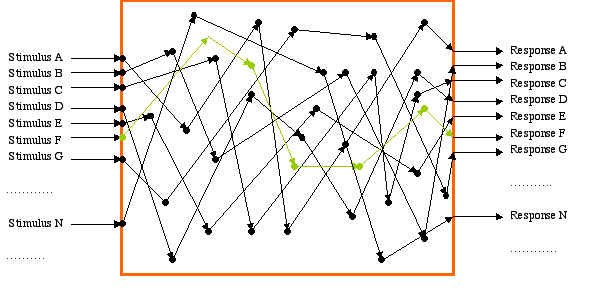 |
The sphaghetti (switchboard, "reflex") box model
Virtues
|
Problems of reflex model
Harvard Law of Animal Behavior
"Under carefully controlled experimental circumstances, an animal will behave as it damned well pleases"
Divergence and convergence
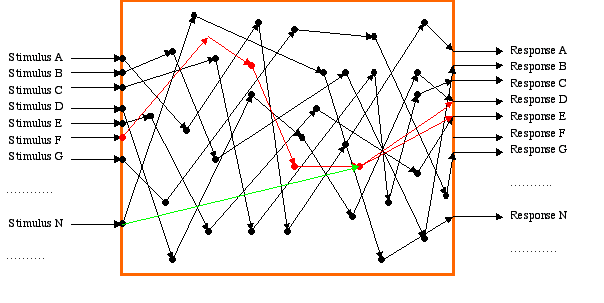 |
Sphaghetti (switchboard, "reflex") plus box model
Virtues
|
A rethinking - boxes in boxes
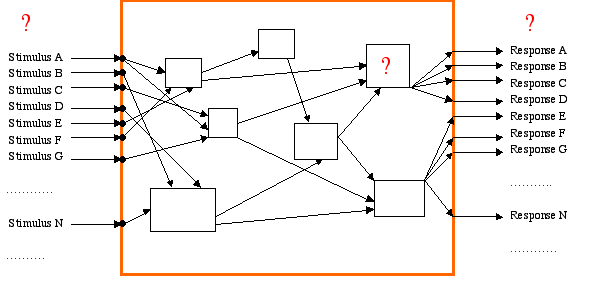 |
The sphaghetti (switchboard, "reflex") box model
Virtues
|
Facing up to the stereotopy, stimulus-response problem ... freeing the box from the outside world, adding autonomy
If brain=behavior then the nervous system must not be astimulus/response machine (nor a bag of chemicals) that is invariant and the same in everyone. It must instead be a different kind of "machine"
- somewhat different in different individuals,
- affected by both genes and experiences/culture,
- capable of
- different outputs for the same input
- taking in inputs with no output
- generating outputs with no input
- a "semi-autonomous" input/output box consisting of input/output boxes.
Go on to look at actual nervous systems to see if they satisfy expectations and to address issues ... further iterations ("getting it less wrong") to come.
The "real" nervous system - an input/output box consisting of interconnected input/output boxes?
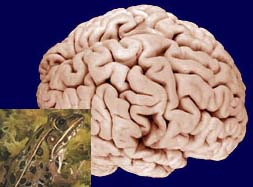 |
 |
| photo from Kemali and Braitenberg, Atlas of the Frog Brain, Springer-Verlag, 1969 |
Caudal to rostral sequence of "boxes" of "central nervous system" originates in neural tube development, is commmon to all vertebrates
(will defer to later discussion of invertebrates, variations among vertebrates)
Each box in turn (somewhat arbitrarily) subdividable into smaller boxes (with some differences among vertebrates, to return to)
And those ... yes, "its boxes all the way down"
From the forum ...
Interconnected boxes inside interconnected boxes
The notion of the brain as boxes inside of boxes inside of boxes ad infinitum as generators and transmitters of inputs and outputs is interesting. And to me, it makes sense. But I have to admit I was a bit dismayed when I first found out we wouldn’t be learning much neuroanatomy ... natmackow
to me, the brain still seems like gook because there are no interstates for me to map ... gloudon
See Washington University School of Medicine Neuroscience Tutorial, University of Texas Health Science Center Neuroscience Online, University of Washington Neuroanatomy Interactive Syllabus, Mercer University School of Medicine Neuroanatomy Tutorial
Trying to analyze "inputs generating outputs, outputs generating inputs, and input output boxes inside other input output boxes" distracts me from the greater point; trying to understand how the brain and nervous system works ... dvergara
Our evolving model of the NS, with its numerous layers of "boxes" and countless neurons and neuronal connections, supports my previous thoughts about infinite possibilities for the brain ... emily
Our model can account for the basic underlying structure in that all creatures are able to get and receive inputs from outputs. It does not do a very good job of accounting for marked differences between different organisms ... Collette
architecture is everything: that the way neurons, the same neurons in every animal, are connected accounts for the differences between a human and a frog brain. And that within the same species (i.e. humans) the connections vary ... cschoonover
Outputs without inputs
I’m willing to believe that it is possible for some outputs of the nervous system to happen without input, but I will need to see some better examples ... kdilliplan
It could be argued that self-stimulation exhibited by some autistic children is an example of the creation of output independent of input ... meroberts
If a brain can give off electrical signals without any stimulus, it implies that it can think without any stimulus ... Jeanette Bates
If the stimulus was not from the environment then how does the brain decide to stimulate an output? Do desire/wants count as a stimulus ? ... mchen
Perhaps I've just had the idea that 'cause equals effect' engrained in my mind for so long that it's just difficult to sway me, but I still feel that there must be some input to trigger reactions in our body ... lfrontino
I still don't think I fully understand outputs generating inputs, since the thought is so counterintuitive ... Lauren McD
See Making sense of the world: the need to entertain the inconceivable
To get to down the road
I think the majority of society thinks that there is a mind, that there is an element of control we have over ourselves, over our brain. If we accepted that everything is a construction of the brain and that everyone is unique, with a unique brain, then how could we establish rules of right versus wrong and how could we ever come to any conclusions on morality and shared human values ... Schmeltz
For me, the most interesting part of the concept of the nervous system as “boxes within boxes” is the idea that some of those “boxes” cannot be opened. That is, some things in our brains happen without our realizing ... araeber
as we go forward with our exploration of the nervous system, I want to be able to define the limits of when a nervous system fails to operate and we could consider it "dead." ... AndyMittelman
The smallest box: neurons everywhere
Invertebrate nervous systems also have neurons, but differently arranged - makes sense?
Neuron as common, smallest box and as input/output element, connected to other boxes
- Cells, like other cells, but specialized to receive/process transmit "information" (as opposed to matter or energy)
- Size scale - tens of microns (10-6) meters)
- Larger boxes must differ in how smallest interconnected
- Relevance of numbers? enough to "account for all the uniqueness that exists among people"? ... 1012exp1012 possible nervous systems?
- Differences between people, differences between organisms due to .... not building blocks but assembly (architecture)
- Need to know how neurons work - to return to
Can use boxes->boxes ... ->boxes(neurons) to show that larger boxes interconnected, in relatively specific ways (anatomical specificity) and to rigorously specify "input" and "outputs" of largest box ... nervous system itself
- grey matter (soma, dendrites, pre-synaptic terminals, neuropil) vs white matter (bundles of axons, tracts)
- central vs peripheral nervous system (some ganglia, but largely axon bundles
- output elements of nervous system (motoneurons, plus) = neurons with axon terminating outside nervous system
- input elements of nervous system (sensory neurons, plus) = neurons with receiving surface (dendrites) outside of nervous system
- everything else = interneurons
- numbers/proportions: more reason to think of ns as "semi-autonomous"
So ... at least parts of our box within box model real ... and helps define "input" and "output" more rigorously
Implies: different regions on brain, different brains, different behaviors largely because of different assemblies of similar elements ("architecture")
From the forum ...
Outputs without inputs?
Why did I just blink, or wiggle my toes, or bite my lip? I have no idea. Maybe environmental factors or restlessness or boredom. I think it is just easier to say that there are outputs without inputs because we really have no way (at least now and i doubt if ever) of accounting for all the possible inputs. By the way, have we even defined inputs? I think in some cases it might be hard to differentiate between output and input and I think at some point it is just easier to say it must be a more circular network ... Schmeltz (and others)
Class this week did clarify for me the idea that outputs can be generated without inputs, but only if one considers inputs as belonging to an environment outside the nervous system ... natmackow (and others)
Definition (for purposes of this course): an input to the nervous system is something outside the nervous system
Observation/conclusion: the nervous system can generate outputs independent of inputs at the time the outputs occur
Questions: is this a useful definition? distinguishes among things normally lumped together as "stimuli"; poses new questions: how does the nervous system do that? what role do input/output relationships within the nervous system play in the nervous system's ability to generate outputs in the absence of nervous system inputs? don't those "rely deeply on the information we receive from the outside world?" (emily and Schmeltz); how does generating output interact with responding to input? what about the loop?
Devoid of any external stimuli, we still wake up ... what other benefits does this “spontaneously generating” nervous system present? It offers us the ability to adapt to new situations and environments. If we could only output based on input, we would be greatly troubled by a new situation ... it allows us to avoid predation that might normally capitalize on routine ... Andy Mittelman
Variation drives evolution, so in evolutionary terms the nervous system is highly valuable ... araeber
I often think in tangents, so knowing we have an infinite number of neuronal connections within our brains models my thinking patterns: as one neuron leads to the next, one thought leads to the next ...because each person has their own set of neuronal connections and because the brain can create its own outputs based on these distinct connections, past experiences, evolution, and learned patterns, we can each be our own self! ... emily
I think that if we only reacted to things, we wouldn’t be able to dream up things on our own. In other words, I’m wondering if there would be any creativity without self-generated outputs. ... Jeanette Bates (see also Colette)
the body can act with a sort of 'free-will' without stimuli ... Lauren McD
I came across an explanation on the emotion sympathy. Damasio described it as "...re-creat[ing] that person's pain to a certain degree internally" and the recreation of the pain does not come from an external stimuli but from a change that is stimulated by the brain itself ... mmchen
Interneurons
when I think of neurons, I automatically assume their function is primarily movement. Basically, when I found out that 99.99…% of neurons are interneurons, it was very surprising ... Saba Ashraf
I wonder if, and to what degree, these interneurons rely on the sensory and motor neurons, which receive and transmit information from the outside world. It seems to me that communication between neurons would only be possible if there was some knowledge of the environment ... cschoonover
All these topics brought me to think about nature vs. nurture, which has been a question I had for long time. I have believed that both have effect on humans, although nature seems to have greater effect. I feel like this talk about large portion of neurons being interneurons and how the structure makes each individual different support my argument, nature has bigger role in human development ... ymi
If the job of these interneurons is to communicate with each other to achieve homeostasis, then I can justify how our communication with the external world demands only 0.000001% of our neurons ... gloudon
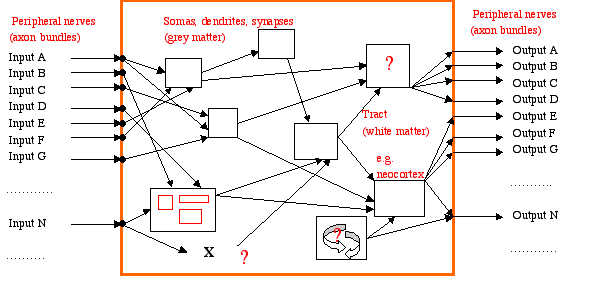 |
The boxes inside boxes (with "autonomy") model plus
Additions:
|
Invertebrate nervous systems also have neurons, but differently arranged - makes sense?
The "real" nervous system - different if behavior different?
- Among different kinds of organisms?
- Among different individuals? within individuals over time? - New imaging techniques
- Notice that differences leave open the question of what causes differences (genes, experiences, activity, culture, etc)
- Implies that "information" can alter matter; not mysterious, "info" turns out to be perturbations of matter organization in neurons, can via metabolic processes influence organization/properties of neurons
Topographic organization - anatomical specificity (input and output locations)
Outputs - (myotomes)
- Motoneurons located at levels of neuraxis related to location of muscles controlled
- Each motoneuron activates only one muscle
- Implications:
- "action" is not one output but pattern of activity across lots of them - "motor symphony"
- source of lots of additional variation in behavior
- lots of outputs/nervous system involved in any "action", is "distributed" characteristic
- need to understand how patterns of activity created, parts coordinated
Inputs - (dermatomes)
- Sensory neurons terminate at levels of neuraxis related to location of receptors
- Implications
- "sensation"/"perception" not one input but pattern of activity across lots of them (across modalities and, as will be seen, in one modality - another "distributed" characteristic
- need to understand how inputs combined
- thought = pattern of activity across lots of neurons
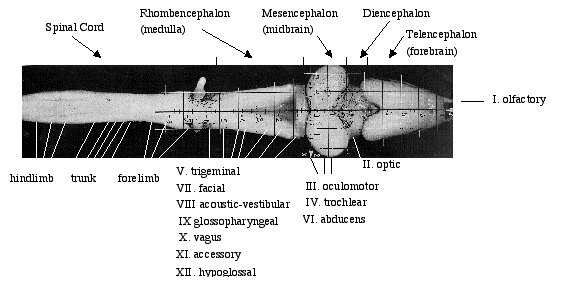 |
For additional information: |
Usefulness of the interconnected box model and ... another box?
- Capabilities of spinal cord
- Quadriplegia (slightly better) - relevance of topographic organization
- Christopher Reeves and ... , from NIH
- The "I-function"
Observations "surprising", but have to be accepted - Issue is "how to make sense of them"
Two kinds of behavior ("reflex" versus something-else) intuition probably not useful
- Spinal cord capable of very sophisticated activity
- Brain capable of quite unsophisticated activity
- Distinction between "reflex" and other things?
- "foot withdraws when irritated" - spinal cord capable of sophisticated activity on own
- is ok ... given topography and "physical contiguity principle ("PCP")
- "person doesn't say ouch when foot irritated" - behavior frequently depends on linking paths within nervous system
- is ok ... given topography and "physical contiguity principle ("PCP")
- "person doesn't move foot when hearing (or reading) request to do so" - behavior frequently depends on linking paths within nervous system
- is ok ... given topography and "physical contiguity principle ("PCP")
- "person says foot irritation not felt/experienced" - behavior frequently depends on linking paths within nervous system
- is ok ... given topography and "physical contiguity principle ("PCP") AND ..
- "behavior" can occur without it being experienced by the behaving organism AND ...
- neuronal circuitry adequate to support "feeling/experiencing" (I-function) is in the brain (spinal cord not needed for this function)
- Where is Christopher Reeves? Is he paralyzed? Does he feel pain? - has to do with "mind", "self", "soul", "personality", "consciousness" ?
- words requiring redefinition in light of new experiences/observations?
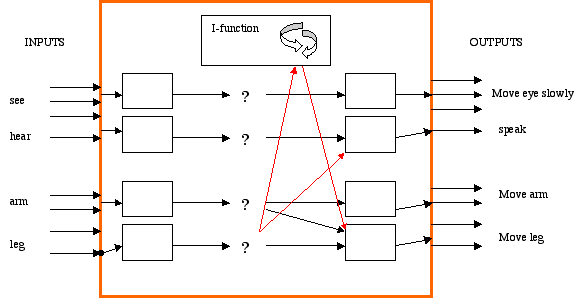 |
Ascending somatosensory pathways Descending motor pathways
|
From the forum ...
Brain and diversity/individuality
Emily Dickinson's idea of the brain as encompassing all is supported by the fact that there is so much variation between individual human brains ... lfrontino
The more similar we are, the more our brains have in common, but any differences we find between ourselves also manifest as a difference in the way our brains are wired (just like every mind is unique, but we can all think similarly, have similar mindsets, etc) ... Kwarlizzie
While no motor neurons are specific for any type of behavior, the way in which all the neurons in the brain receive, process, and transmit information creates interesting and diverse patterns of motor neuronal activity (behavior). This slightly more empirical explanation for the individuality of human behavior feels more right to me ... natmackow
in the studies that I’m familiar with, mostly psychology, we cannot test a hypothesis on every single person in the earth, therefore we select samples to represent the whole population. And when there is statistical difference above certain level, we assume that this is true and can be applied to the large population. Therefore, I’m not really sure why we can’t say there is difference between brains of men and women ... ymi
If we imagine different phenotype of a gene as an axis, we may see an end as "completely male" and the other "completely female", but most people's traits will probably fall between the two, and there are no breaking points on the axis ... these gradients are not limited among organisms of the same species, but also through the line of evolution. When we look at brains of different mammals, we can see that as well. These gradients create infinite possibities of the biological world ... Congen Wang
it became apparent that there really was no specific difference between women and men, but there was a difference in a statistical point of view ... Saba Ashraf
In all our discussion about how brains are somewhat the same, somewhat different, how can we possibly quantify and qualify mental illness according to one standard book? .... molivares
The "I-function" as a box?
Does this I-function = mind? Or do we normally associate mind as being disembodied or separate from brain? Is this I-function unique to mammals? Is it unique to humans? ... Schmeltz
The idea that the mind can assess itself or that you can view you outside of your brain is suggestive of a second brain(mind/soul) ... Raven
What does it feel like not to recognize yourself? Are emotional connections essential to the sense of self, or the I-function? ... Riki
I wonder if pain is a part of the I-function box? ... cschoonover
I still do not understand why we seem to equate the I-function with the "Self." ... dvergara
Does this mean that breathing sometimes falls under the I-function and sometimes doesn’t? Or does it mean that breathing is connected to more than one part of the nervous system? ... Do other animals with brains have I-functions, even if we as humans don’t generally think they have a sense of self? We seem to be choosing to use the term “the brain” to refer to the whole nervous system in some cases and as a section of the nervous system in other cases. I wonder if the issue of what is and is not governed by the brain might be cleared up by being more careful how we define the brain ... kdilliplan (see also Jeannette Bates
I'm having trouble getting used to the idea that part of my brain isn't me. I wonder if it is a "box" in a sense that we might one day be able to pinpoint the part(s) of the brain that is the "I-function?" Or is it simply another way to explain consciousness? ... araeber
I guess I'm just trying to sort out what is part of the I function and what is not. Trying to figure what I can and can't control ... mcurrie
If a sensation or a motion is caused by a pattern of activity across lots of output and input elements, does the "I-function" idea mean that our consciousness and self-awareness, "actions" of our mind are products of a pattern of activity across lots of output and input elements too? ... emily

If its all sensory neurons, motoneurons, interneurons, and signals moving among them (the I-function included), we need to look at signals, what they are, how they're handled ...
Signals:
- Resting potential
- Action potential
- Receptor and generator potentials
- Synaptic potentials
Start with action potential, use it to raise questions that will lead to explanation of resting potential, use those ideas in turn to successively build up a set of more basic ideas that collectively account for all signalling.
- continual motion (diffusion)
- concentration gradients of charged particles (ions)
- specific membrane permeability
- passive current flow
- variable membrane permeability
Action potential - longitudinal battery which appears/disappears successively at successive points along an axon ("travels" at finite speed), "all or nothing" transient (millisecond range) event
- Helps to account for "thinking takes time"
- Is the common currency of "information" in nervous system cables (axons, axon bundles), of all organisms
- Problem: how distinguish action from perception from thought?
- Solution: anatomical specificity ("see thunder, hear lightning")
- Is way to "see" otherwise unobservable
- Need to understand it - doing so will help make sense of other potentials, provide further insights into how ns COULD be behavior
To understand action potential, need first to understand resting potential - transverse battery, continuously present, with potential for continuous variation
| Organization based on random motion |
- Diffusion
- Selective permeability
- Charged particle movement, balance of diffusion and battery creation
- Stable transverse battery, with potential for variation
- Concentration gradients, energy dependent ion pumping
- Can get action potential? what more?
From the forum ...
More on the I-function
The "I-function" is our sense of what we can do based on the capabilities of our nervous system ... Schmeltz
it does seem to function as a “box” that creates a representation of the nervous system. It almost allows the nervous system the ability to view itself, its actions, its inabilities ... natmackow
If the I-function is a discrete box, and may be malleable (as in the case of Christopher Reeves), could you alter its boundaries through methods other than injury? ... AndyMittelman
Interesting that we can distinguish "detection and analysis" of input from the "experience of seeing," and that that which we consciously experience bears little resemblance to what our nervous system experiences. It makes me question the "stuff" of the self -- how can we have any sense of self awareness if we are not aware of most of the ongoing functions of the nervous system? And at the same time, how can we function in any other way but with ignorance to this thorny reality? If we embrace the uncomfortable notion that we are mostly products of our unconsciously- functioning nervous system, what happens to our individuality, our sense of self, our ability to understand -- or begin or pretend to understand ourselves -- so that we might understand others? ... egleichman
Resting potentials, action potentials, and batteries?
|
Ionic concentration gradients, differential membrane permeability, AND random motion create a transmembrane battery Changing permeability without changing concentration gradients changes the transmembrane battery Adjacent membrane regions with differing permeabilities will have different transmembrane batteries In this case, there will be batteries along the membrane both inside and out, resulting in passive current flow Passive current flow is essential for action potential propagation and other important aspects of neuronal function |
I usually think of batteries as something so industrial and metallic. I don't really associate my organic brain with something like this ... lfrontino
the model of battery is too simplified ... the potential across membrane is established and maintained in a much more complicated fashion ... Congwen (see also molivares)
I did find the example of battery to represent axon very interesting and helpful. Some people have mentioned in the forum that battery example might be oversimplifying what the brain actually does. I agree with this, though I liked the example for this reason ... ymi
all it took was a selectively permeable membrane and a concentration gradient of the ions to create this battery ... Saba Ashraf
Thinking of the electro-chemical gradient along the axon, of the negative/positive charges, as a series of batteries moving across and along the axonal membrane actually made the concept easier for me to grasp ... The idea of the batteries across the membrane and ALONG it, thereby propagating the action potential, made more sense than the idea of chemical and voltage gated channels and pumps... doing things ... kgould
Learning about how signals work could definitely help with understanding the whole output without input where a signal could start in an axon without getting a signal from some connected neuron. This could be due to the "battery" movements and with their movements they create a potential that occurs in the axon and then creates an action. This signal would then not be influenced by an input either from another neuron or from an outside stimulus. I'm still wondering if the output signal is random or not since the movements of ions or molecules are random ... mcurrie
The transition
the gap between neuron firing and the I function is so great that it is hard to know where to begin to fill it ... Neuron firings are like the building blocks to the I function, except that there are many stages before the I function is reached ... Lauren McD
I think that the transition from the I-function to neural signals is just fine. One part that I found especially important was the fact that “all neural signals are the same, it is the neural pathways that are different.” I think that this fact can help explain why only certain things are affected by the I-function, or at least the I-function as I see it. In order for something to be a part of the I-function, it would have to be connected to specific pathways that send signals from the part of the brain that has the I-function to specific parts of the body. “We” are connected to the parts of the body that we control. Literally. But more importantly, I think that talking about multiple pathways and connections can also help me understand why sometimes things seem to be a part of the I-function and why they don’t at other times ... Jeannette Bates
Even though Christopher might not be aware that he can move his hand, the neuronal signal that will enable his hand to move still exists. And it's the same signal as the one that makes him think that he can't move his hand ... meroberts
If someone were to ask me to wiggle my toes, I’d simply wiggle my toes. I wouldn’t initiate an action potential in the section of my brain devoted to the I-function that would then tell the nerves in my foot to tell the muscles in my toes to contract and relax, producing the behavior known as toe-wiggling. As far as I know, people aren’t capable of directly influencing the most basic behaviors of their nervous systems just by wanting to ... kdilliplan
I think, "i'm going to wiggle my pinky toe," and sometimes it wiggles, but usually it wiggles along with the rest of my toes? I didn't tell them to wiggle. To me, this seems like sometimes the i-fuction is messing up ... gloudon
wonder how these signals from action potentials are transformed into the thoughts, feelings, desires, etc. that we experience daily ... cschoonover
The I-function is neuronal signals, I think. The transition is reasonable for sure, and even if you believe in a distinction between the brain/nervous system and the mind/I-function, it's an awesome thinking exercise ... emma wipperman
And on ...
Learning about how signals work could definitely help with understanding the whole output without input where a signal could start in an axon without getting a signal from some connected neuron. This could be due to the "battery" movements and with their movements they create a potential that occurs in the axon and then creates an action. This signal would then not be influenced by an input either from another neuron or from an outside stimulus. I'm still wondering if the output signal is random or not since the movements of ions or molecules are random ... mcurrie
I feel that the analysis of neuronal signals in relation to the I-function complicates matters due to the unanswered question of where/how do signals start. Is there a certain "box" which is the source of all the signals and it is the only box that can generate an output without an input? ... mcchen (see also MEL)
Action potentials allow connections to interact, but do they help form connections? ... How do connections become learned? ... a summary of this string of questions: What's up with connections????? ... emily
action potential: adjacent membrane regions with different transverse batteries (because of different selective permeabilities) - Issue then is how to get it to MOVE, with finite velocity?
Propagation
Notice it is NOT matter moving, nor energy, it is a perturbation (signal, information) |
Will propagate if started. How affect things? How started? Need to understand synaptic potentials, receptor potentials, but first ...
Lots of things can start it. Among them is something that provides answer to one of our box questions ...

And the big question ... Do signals actually start in the middle of the box? If so, how?
Yes, not mysterious, follows from what we know,if we add possibility of some differences in permeability of some membrane regions not mysterious, has interesting implications ...
- brain in a vat
- action without "personal responsibility"?
- epilepsy
- other things?
Go on to receptor potentials, synaptic potentials (how action potentials affect things, how boxes integrate, how signals stopped in box)
Input (sensory) signals - an example
- Neuronal receiving surface outside nervous system (alternate1)
- Sensory transduction - specific channels varying permeability in response to external events
- Receptor potential - continuously variable in space/time (like passive current flow
- Transformed into action potentials
- Coding in pattern of action potentials
- Significance for behavior?
- Restricted sample of "reality"
- All representations of "reality" in same form, in same signals as those created in nervous system itself
- Anatomical specificity IMPORTANT ("hear lightning, see thunder")
- Extra-sensory perception
- "five senses"?
- proprioception (muscle spindles, tendon organs, plus)
- pheromones
- others?
Synaptic potentials - Synaptic integration
- action potential vanishes at synapse
- intermediate chemical step: neurotransmitter release and ... (multiple control steps)
- permeability change leads to synaptic potential (alternate), also continuously variable in space/time
- summation - neuron as integrator rather than relay
- inhibitory synaptic potentials, algebraic summation
- is how to "stop" signals - significance for behavior?
Complexity of synaptic interactions
- Lots of neurotransmitters
- anatomical - e.g. presynaptic inhibition
- multiple steps in synaptic transmission - e.g. neurotransmitter inaction/reuptake
- use-dependence
- synaptic facilitation, depression, habituation, long term potentiation, heterosynaptic facilitation and Hebb synapses
- additional indirect effects of receptor activation - e.g. neuromodulation, metabotropic synaptic activity
- signalling linked to cellular metabolism (an example, another)
- nervous system as continually evolving
Chemosensitivity not restricted to synaptic regions
- hormones, other materials, external agents (drugs, food, etc)
- "chemicals" can be an input/ouput, modulates "state" of network
- pharmacological as well as anatomical specificity
- we are not "bags of chemicals", but may be patterns of activity that reflect in part chemical neurotransmitters and can be modified by the chemical environment
- pharmacotherapy: rationale and limitations
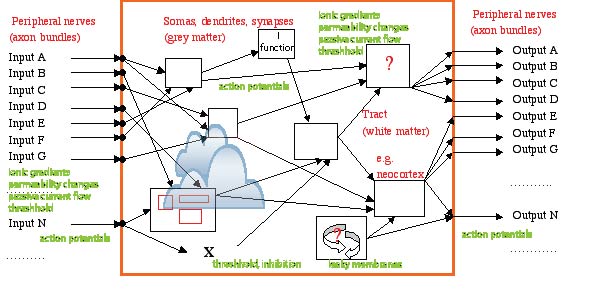
Is the brain a machine? a computer?
- "salt running in and out of channels"
- multiple interacting processors
- combined analogue and digital processing
- use dependence, no clear hardware/software or processing/memory distinction
- both local and broad band signalling
- internal autonomy, randomness
- "I-function"? itself "salt running in and out of channels" (and therefore can affect other boxes)
- functions not visible in elements that appear because of higher level architecture
Problems solved, new issues raised ...
- got inputs, outputs, boxes inside boxes
- got signals starting in middle, ending in middle
- got "I-function" as box
-
- report of internal state
- effect of external event on internal state
- action based on internal state as opposed to simply external state or "causeless"?
issues of "self", "consciousness", "free will" not avoidable - if such terms didn't already exist, we'd have to make them up to make sense of studies on the nervous system ... "I-function" one way into them
-
- got general sense of how smallest boxes work
- integrators, with own contribution
- anatomical specificity, local information transmission
- pharmacological specificity, local and more global information transmission
- modified by their own activity/function
- implies all aspects of behavior/experience correspond to patterns of action potentials in neurons (modifiable by hormones, drugs, etc). Important "micro" base but also already some important "macro" understandings. Behavior/experience
- involves distributed patterns of activity
- changes due to its own activity
- is sensitive to chemicals
- does not always have an external cause
- may be as much a function of inhibition as excitation
From the forum ...
It makes me wonder, what else is going on in the world that we aren’t aware of? As humans, we always consider ourselves to be the most aware and in charge of the animal kingdom, but it is probable that other animals are responding to certain stimuli that we have no idea even exist ... It reminds me of colors, and how different people may have different perceptions of ‘blue,’ but we would never know it, since we can’t see through their eyes ... lfrontino
what makes us so sure that our ability to detect hormones is not somehow a part of one of the “big five” senses? ... Jeanette Bates
I had always imagined one signal moving through various connected cables; however, signals end in the cables and do not exit it. This lead to the idea that our neurons were extremely advanced and somewhat like a computer. Despite getting about 1,000 signals, neurons are still able to make their own signals based on the numerous signals they receive ... Saba Ashraf
the brain is made up of all these "computers" which dictate our behavior. The term "computer" sounds very mechanical which makes me think that anyone with a mental disorder can be taken to a mechanic and be fixed immediately ... mcchen
if neurons are computers, then what happens when we forget? Is forgetting just a malfunction of a neuronal signal path? If this is the case, are long term memories and short term memories in different computers because they are in different parts of the brain? ... gloudon
The description of neuronal signals as a computer does seem a little overwhelming to me at first. I have a hard time internalizing the “hard wiring” we have inside our heads ... Andy Mittelman
I've learned about neuron firings and I've learned about behavior in previous classes, but I never truly had a course in which I learned the processes between the two ... LaurenMcD
There has to be a reason why a signal follows one path instead of another. How did the brain get to be the way it is? How and why are some connections made and others not made? ... aeraeber
Our memories "exist as subtle shifts in the strength of synapses", but what about ideas and thoughts-- original, or are they also triggered by past experiences? Are ideas and thoughts merely spontaneous/random outputs from neurons triggering a pattern of neurons? How does this pattern know how to travel? If "random motion" (of ions) causes random outputs, how come our thoughts and ideas are so organized? Is "inhibition" a major key in organization? ... Emily
In terms of thinking, when a neuronal signal is propagated, is the output a sound, a word, or a sentence? How is thought created from neuronal signals? In order to make sense of all of human behavior and experience, I think we need to explain how neuronal signals relate to emotion, thought, and other complex human actions ... MEL
What makes a brain a mind? ... Collette
"Advances in neuroscience put it increasingly in conflict with criminal law: If all our mental states can ultimately be reduced to neurophysiological conditions, and there is really no such thing as free will, how can people be held accountable for crimes?" ... Hannah Silverblank
With signals in hand, return to discussion of architecture (non-traditionally) with output - "action"(since not all outputs can be accounted for by inputs and, it will turn out, outputs can affect both inputs and the processing of them, the nervous system, like science, is "loopy") - between neurons and behavior are ... patterns of signals - where do "patterns of signals" (action potentials) come from?
| Action = "motor symphony"
A new concept: the reafferent loop Accounting for motor symphony
|
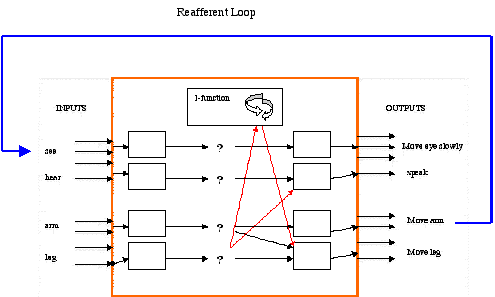 |
Reafferent loop
- exteroreceptors and
- includes
- joint receptors
- Golgi tendon organs
- Muscle spindles - stretch "reflex"
- raises interesting issues about ns/behavior, I-function
- more looking backwards/upside down: NS generating outputs to get inputs?
- "Maybe a leaky membrane in my mind causes me to think of neuroscience question in class...and THEN I generate my motor output (writing down the question), which allows me to have visual and tactile input (my written characters themselves) ... Jackie Marano
- How many "senses"? Why traditionally 5?
- General issues to be returned to - stretch reflex (alternate) relevant in re earthworm locomotion (among other things)
Preliminary human evidence?
- "central pattern generation" but ...
Looking more closely at the "central pattern generation" hypothesis
Implications of earthworm case
- Reafferent patterning
- Central pattern generation?
- NS has "five ways to do same thing", proving A does not disprove B]
Motor symphonies, reafferent loops, and central pattern generation

Crayfish - swimmeret (female, male) beat (more)
- nervous system - more detail
- central pattern generation?
- common in lots of organisms, including humans
- may be genetic (cricket song), or result of experience, usually both
- what/where are central pattern generators?
CPG as premotor circuits, interconnected neurons
Motor sympony lacks a conductor - coordinated performance of independent players (cf. Boids, flocking, fireflies) - efference copy = corollary discharge
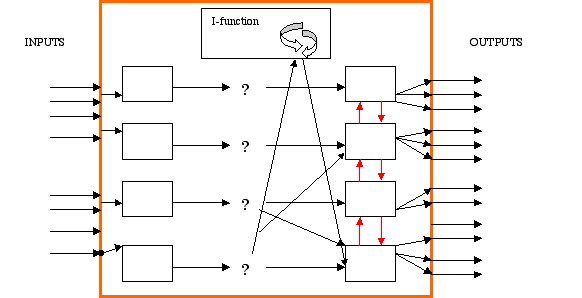
From the forum ...
Unsteady and wobbling, the baby Cuckoo positions the unhatched host’s eggs onto the dip in its back and pushes them toward the edge of the nest and with a determined thrust, expels the egg out of the nest. The Cuckoo repeats this action until all the remaining eggs are rid of the nest. (If you want to see this behavior for yourself, watch this http://www.youtube.com/watch?v=DbvDQjhO9nY&feature=player_embedded) ... I found this behavior quite fascinating. At first was hard for me to understand how a newly hatched Cuckoo could carry out such a complex, nonlearned behavior. I now see that it is a central pattern generator, or a circuit of neurons, that allows this behavior to play out so early in life ... molivares (see also meroberts on Bambi)
Because we have memory stored in the form of central pattern generators in parts of the nervous system other than the I-function, I finally was able to convince myself that a paraplegic dog does in fact have the ability to wag its tail ... This leads me back to Christopher Reeves. If Reeves became sexually stimulated would his brain activity generate hormones that then induce an erection? ... Schmeltz
Mary Roach addresses the question of sexual response in people with spinal cord injuries in her book Bonk: The Curious Coupling of Science and Sex. She recounts several studies which have shown that the right stimulation can produce erections and orgasms, even if the people are unable to feel it ... kdilliplan
makes me think of tourette syndrom and its almost random jerking movements of the body. Is C.P.G involved in making these jerking movements occur without the need of any apparent input that causes them ... JJLopez
Central pattern generators may help us and other organisms function more quickly and efficiently and in a more coordinated manner, but I would think patterns can also be very limiting. For instance, when I used to play a musical instrument I would often need to memorize the pieces of music I was learning. I occasionally had difficulties keeping the different pieces separated, especially if they had phrases or rhythms in common. I’d begin playing one piece and end up playing a different one because I was relying on the patterns I’d formed for each piece and paying less attention to my performance ... kdilliplan
Usually, we assume that we can locate a function by showing the function is nonexistent when part of the nervous system is removed. This seems to make sense at first, but we don’t actually know all the parts of the nervous system that account for this function using this method. Basically, we can’t conclude right away that the part nervous system that is removed is the only thing needed for the function. However, the opposite appears to be true because if the function exists when part of the nervous system is removed, then we know for a fact is it not needed for that function to persist ... Saba Ashraf
CPG's and sensory input
Although I repeatedly perform daily activities, I never do them in exactly the same way. Do central pattern generators create the action in its most basic form and then other neuronal pathways tweak the output? ... MEL
although there is a pattern stored in the central pattern generator, how do we adjust it to suit different conditions? It seems to have something to do with the reafferent loops, but how do the two processes interact? ... Congwen Wang
CPG's and genes
we discussed how behaviors are either learned or acquired through genetics. It's interesting to think that something perceived as such a critical learning process in our lives is really not learned at all, but would be reached eventually anyway. What other processes are actually inborn in us? ... lfrontino
If a baby bird with its wings clamped wasn't able to observe other birds flying, would it still be able to fly? ... Lauren McD
What if we innately “knew” how to ski or how to shoot a bow and arrow? I’m curious as to how this applies to swimming ... AndyMittleman
In an environment with no talking, would a human instinctually try to speak (can we ever know?)? ... egleichman
CPG's and individual experience
I began playing soccer when I was six and it was definitely not an innate set of actions. Kicking a ball, aiming my passes, and using my non-dominant foot were awkward, frustrating actions. I knew what a specific move looked like but, no matter how hard I tried, I could not will my body to to recreate it smoothly and skillfully. It took me a while to realize that if I practiced passing, shooting, or even certain moves over and over again, they would become almost instinctual when I played with my teammates. And so I began creating CPGs that worked together to create a motor symphony of soccer skills ... natmackow
I took piano for several years; I would say that I was even pretty good at it. I quit it in 10th grade, but a few years later, I tried to sit down and play it again (without touching it since that period). I could only play simple melodies ... Jeannette Bates
I feel like there's a linguistic or conceptual issue at the root of this idea of Central Pattern Generators—that is, what is "learning?" If, for example, a CPG exists for walking, does that mean children do not "learn" to walk? Can we "learn" a new action if the blueprint for that action is already present in our nervous system, just waiting for us to use it? What exactly is going on as children try and try to walk—or as birds try, over and over, to fly out of their nests those first few times? ... smkaplan
It's true that it takes a while for children to learn how to walk, but all children instinctively know to try to learn how to walk, which is even cooler ... We need exposure to language to learn it, but we don't have to be taught: there are pathways already established that allow us to acquire language very easily ... Emma Wipperman
"Forgetting, With a Purpose" by Sindya N. Bhanoo (http://www.nytimes.com/2010/02/23/science/23obflies.html). The article explores how short-term memory might not just fade, but rather is actively erased in order to clear up space for the brain's storage system ... Hannah Silverblank
CPG's and the I-function
I realized that during several piano recitals I did have to try and not think about what I was doing. When I started thinking about the piece I was playing or the what the next part I had to play sounded like, I would mess up. I realized that I had to actively not think about anything, I had to clear my mind completely in order to play a piece from memory ... mcchen
CPG's beyond movement
I do not think CPGs fully explain interconnected neuronal circuits in general. Our actions are very fluid; we can most often move without thinking about it. But what about THINKING? Of course thoughts are influenced by other inputs, certainly sensory, but are there CPGs for thoughts as well? ... Emily
Just as we have physical motor scores, we probably also have mental scores. Maybe this explains why certain things are engrained in our brain and it doesn’t take cognitive effort to recall them. If you ask a small child their address, they would probably give it to you in one unbroken continuous memorized sentence ... AndyMittleman
Even if we think about the same idea more than once, we think about it in different ways each time and while changes in physical actions tend to be based on changes in sensory inputs that is not usually the case with thinking ... aeraeber
Corollary discharge and distributed systems
Towards the end of class we concluded that the nervous system consists of a bunch of interacting parts with no one in charge, meaning it is a fundamentally distributive system. At first it seemed odd to me that a complicated system could produce such sophisticated behavior without a conductor, without someone to report to. However, after going back to the examples used in class, it’s starting to make more sense ... cschoonover
Look at some more uses/implications of corollary discharge:
- role in "perception"
- role in body sense
- comparison of expectation/input
- role in behavioral choice - Pleurobranchea
More on CPG's
Babies are born with the central pattern generator to walk, but they are not born with the abilities to balance, use certain muscles, etc that are necessary for walking. So in a way, learning and maturation are linked into the walking process ... Lauren McD
This may relate to musicians preparing music to be performed when they study the music to be performed without actually performing the music in order to prepare themselves to play a composition ... Collette
Does each innate skill get its own CPG? Or, can multiple, similar things be stored in one central pattern generator ... gloudon
So if we have these CPGs, and we're creating (and modifying) CPGs all the time, then what else can we do that we don't know about? ... AndyMittelman
in many Asian cultures, the right hand is the preferred hand of choice and grandparents or parents sometimes uses force to establish the dominant hand. But, if you place the a utensil or pencil in front of the child, it will choose which hand it would like to use by itself without any external stimuli. Its an innate ability just like walking, eating and breathing .... mleung01
one day, my Mom was completely fed up with my refusal and complaints to get in the water so she picked me up and threw me in the deep end. I was shocked and pissed off, but I swam to the surface and to the side of the pool with no problem ... It makes you wonder what other CPGs we have that our minds are continually blocking due to emotions and environmental factors ... this suggests that your experience of things is a function of not only sensory input and CPGs, but also your own state of mind ... Schmeltz
Does it make sense to think about songs that are stuck in someone’s head as a repeating pattern of signals that may or may not have an input trigger? ... Recurring dreams might also be similar ... kdilliplan
If we are born with CPGs for specific motor patterns, does this extend beyond movement? For instance, are we born with CPGs for thinking? ... cschoonover
Corollary discharge
Learning about corollary discharge taught me that the problem with phantom limb syndrome is not because one “believes” something, therefore it happens even though it’s not really there, but there really is brain chemistry that explains why brain acts that way. I don’t know what I’m saying makes sense for others, but it is kind of legitimating the syndrome ... yml
some child scrapes their knee and doesn't feel the pain. But when someone points out they have a cut and the person looks down then the cut starts to hurt and with children they have the sudden reaction to cry. Why when we get the cut is there no pain? ... mcurrie
I have noticed that I get car sick when I am in the backseat of a car but never when I am driving. This also makes sense in the terms that is due to the non-correspondence between sensory input and corollary discharge ... MEL
I get carsick rather easily, especially on the blue bus, and my friend has always told me that I should look out the window when I get carsick. Whenever I do, I start to feel better. I now recognize that my body happens to be very sensitive to conflicting signals. My inner ear is telling me that I’m moving, but when I’m reading or even just looking at the head in front of me, my eye’s sensory neurons are telling me that I’m not moving. When I look out the window, however, I see movement, and so the conflict goes away ... Jeannette Bates
it would be interesting to find out why I only get motion sickness when concentrating on a book, but not on a puzzle ... Saba Ashraf
What causes one person to become more ill than another given similar sensory input? ... natmackow
I guess watching 3D movies can be interpreted as a type of motion sickness ... mcchen
If corollary discharge is a mechanism in the brain that allows one to distinguish between self-generated and external stimuli or perceptions then what role does it play in the awareness of others in the case of anosognosics? ... molivares
this gives more evidence for the idea that every one inhabits there our reality, their our universe .... It’s sort of a frightening thought, that we (humans in general) don’t really have a common reference point of experience. No one will really ever understand what another person is experiencing ... araeber
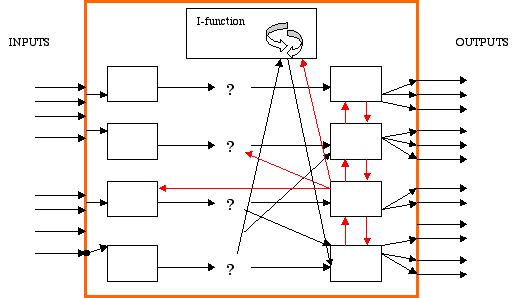
Look at some more uses/implications of corollary discharge:
- role in "perception"
- role in body sense
- comparison of expectation/input
- role in behavioral choice - Pleurobranchea - leech
Can account in terms of neurons for
- Outputs related to inputs
- Outputs without inputs (CPG and spontaneous activity, "will"?)
- Different outputs for the same input (corollary discharge, "choice"?)
- Differing behavior in different people (genes, changes in ns due to its own activity)
- Can do all of that without "I-function"
Have still to account for
- consciousness
- culture
- reality
- purpose, meaning
- ????
Have some useful "boxes"/concepts from thinking about output side in terms of possible origins of motor symphonies ... and some new questions
Output affects input ... input affects output?
Let's reinstate input and reafferent loop, see what new things that gets us
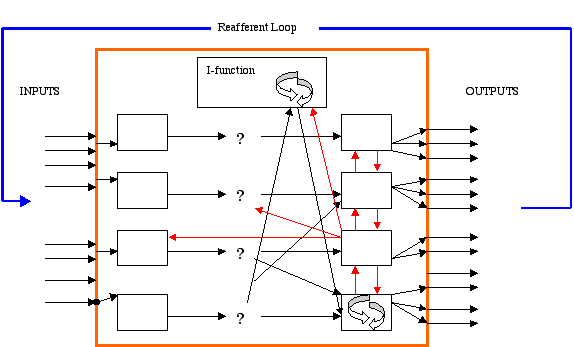
I. Getting it less wrong - comparison of what one expects from an action with the results and updating
| Linear science | Seriously loopy science |
 |
|
Adaptation in the vestibulo-ocular reflex and saccadic eye movements
II. Not an input-output pathway but a feedback loop
Stretch "reflex"
- input causes output; output causes input - no "simple" cause/effect
- negative feedback - stabilizing, "purpose"?
- thermostat - variable setpoint
- temperature regulation
- weight control
- others?
| Since this is mid-term, I want to write kind of a midterm reaction post. I was just amazed by how much is going on in our head and how much of them happen unconsciously. I’m the type of person who needs to know what’s going on around me, why it’s happening, and have control over them. However, as I learned about brain and behavior for 6~7 weeks now, I realize how much I don’t have control over my actions, behaviors, thoughts, etc. Also, it’s irony how brain works is so effortless ... but understanding how that worked takes lots of effort to study and understand. After all, my brain knows all that. Otherwise, how would it have done those? But I don’t know how they happened! I need to learn how my brain worked by looking at other people’s brain activity or even other animals’. I could get really frustrated by this fact! But I will rather try to learn more and understand better ... yml |
In search of the I-function
Many more boxes/tracts relevant to output side of nervous system (alternate) - more and more
Cerebellum, basal ganglia as "loops"
- Cerebellum and "motor learning" (without the I-function)
- Motor imagery (the I-function without action)
Focus on motor cortex
- Somatotopy (topographic organization) - "upper motoneurons"? plus, projections
- frogs don't have motor cortex - not needed for movement?
- decerebrate rigidity, spastic paralysis
- human
- cat
- three-toed sloth
Role of motor cortex?
- inhibition
- fine motor control, exploration?
- "voluntary/involuntary movement" distinction - with/without "I-function"?
Recapitulation: (looking back)
 |
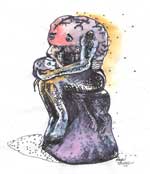 |
Lessons learned "from the output side":
- There ain't nothing there but neurons (ion flows, permeability changes, transmitters ...), interconnections among neurons, information processing
- Action = motor symphony = spatio-temporal pattern of activity across lots of motoneurons
- Symphonies may be based on internal scores and/or afferent/reafferent signals (usually both)
- Symphonies may reflect prior inputs and/or genetic information (usually both)
- Symphonies may be endogenously generated and/or triggered by inputs (frequently both)
- Inhibition plays an important role in determining what symphonies are played
- Symphonies frequently involve distributed performances with corrollary discharge signals creating coordination
- Outputs affect inputs and their interpretation, both via the outside world and via corollary discharge signals
- Corollary discharge can create elements of what appears to the external observer to be "choice"
- Feedback organizations can endow systems with what appears to the external observer to be "purpose"
- Action can occur without involvement of the "I-function" or the neocortex
- Damage to neocortex abolishes the ability to create "voluntary" movement but not the ability to generate motor symphonies nor to do so in complex and "adaptive" ways in response to sensory input (relevant to the Terri Schiavo case?)
It is interesting that I did not feel pain until the blood and the concerned look on my friends' faces suggested to me that I should feel pain ... Schmeltz
It is funny that something which seems to be in our control, weight loss and gain is really not, as there is a certain set point that changes with age which we cannot deviate from without consciously thinking about it, while something that seems to not be in our control, pain, really has to do with our state of mind and is something we can have more control over ... emily
This idea of not having control over something as close to you as your own weight is intimidating, and not greatly believed in our society full of advertisments of lowering your body weight ... Lauren McD
individuals with hyperthyroidism ... seem to lose weight despite the fact that they have not changed their daily routine or the foods they consume. In these individuals it seems that an outside force (from the NS/I-function), the thyroid, determines the set points for an individual’s weight, body temperature, and perhaps the balance of chemicals in the brain related to anxiety and restlessness ... nmackow
[bird song observations] This reminds me of the fact that certain people can sit in class and hear the instructor talk, yet unless they go over the material on their own, they don’t have much understanding of the material ... Saba Ashraf
Birds occasionally learn the songs of different species, or they somehow manage to create a new song by incorporating pieces of their species’ song and another’s. Obviously, not every bird gets confused and learns a different species’ song, but every bird is exposed to other bird songs everyday. So, what's wrong with these birds? ... is it possible for humans to get confused about which animal they are supposed to mimic? ... Jeanette Bates
interaction between individuals is highly important to the learning process, but doesn’t directly fit our auditory template & trial and error model from class. I suppose it would fit our model if we expanded the template idea so that the template is not only an auditory one, but also includes social cues as well ... kdilliplan
I would not say that I am dyslexic but I do have trouble distinguishing between my right and left. Even with external stimuli, such as someone telling me to turn left or right, my body naturally turns towards the left (left-handed) unless I put some thought into it. The same situation when it comes to shaking hands. I see that the person has stuck out his/her right hand and yet I still extend my left hand. I guess what I perceived was not being translated correctly ... mleung01
So if this whole thing is going on constantly, why is it that we evolved to do this process largely without involvement of the i-function? In other words, why is it that the i-function plays such a removed role in this complicated and constant event? I suppose this is just one of many events that occur constantly without our conscious consent. But can we override this? As in, if we tried to take a deliberate stance against getting seasick (and tried to consciously accept the disagreement between corollary discharge signals and sensory input), could we successfully suppress the impending seasickness? I don’t think so…at least I’ve never seen anyone succeed at this route ... AndyMittleman
It seems as though the I-function is present to excite and inhibit the instinctual functions of the nervous system. Does this mean we really can't "control" most of the functions in our body? Since the I-function only gets a glimpse at what the nervous system is up to, we really don't have enough information to try and control what the body can and cannot do. So then is it the I-function that can process external/environmental factors in order to make conscious decisions about how to react in certain situations? ... mcchen
I guess I'm just thinking about all the connections and keep wondering about what occurs when one of the connections, CPG's, I-function, corollary discharge is not functioning properly. With paralysis the I-function has no effect but the CPG's are still able to respond, while in a coma the I-function doesn't seem to be working or CPG's but maybe corollary discharge is still telling neurons what's going on in the body, keeping it aware of the outside ... mcurrie
Maybe further exploration into the involvement of the I-function in choices outside of biological processes would help explain what we refer to as human choice, those decisions that are made every day that do not concern the functioning of our bodies ... cschoonover
Is memory, declarative memory that is, a separate box or is it part of many other boxes? ... araeber
 |
 |
Can we make sense of behavior in terms of the nervous system (Dickinson vs Descartes)? Tools acquired to date ....
- sensory/motor/interneurons, action potentials, spontaneous activity, chemosensitivity, excitation and inhibition, synaptic integration, activity changes neurons and their interactions
- patterns of activity, distributed organization
- central pattern generation
- corollary discharge
- feedback loops
- processes with and without "I-function" involvement
Coming in from the sensory side - different/similar/additional?
Recall sensory neurons (specialized permeability changes) constrain "view of reality" - ns only "knows about", "can respond to", "has information about" things it has specialized neurons to transduce signals about
- The "classical inputs": Seeing, hearing, smelling ... touch, taste
- Additional inputs, including proprioception, pheromone detection, and ... ?
- Extra-sensory perception?
- Info the nervous system has without the I-function about it?
- Information from sensory neurons neuroscientists don't know about?
- Information that "self"/"mind" has which doesn't come through sensory neurons?
- telepathy
- remote viewing = clairvoyance
- precognition
- Science and Spirit
- The Physical and the Spiritual: A Conversation About "How To Get Through the Veil"
- Further evidence, in any case, for "encapsulated" I-function
Interesting extensions of central origin of perception
|
Recall "labelled line" - see lightening, hear thunder because different neurons activated, send action potentials to different places
- Good first approximation but ...
- Pain?
- Synesthesia
- Complication of "perception" ... "I-function"?
- Stay with labelled line idea, one modality
Vision as a paradigmatic case (is it? ... is at least best studied, and shows some general principals)
- "Seeing" vs light-detection
- Critical feature is information about differences, in this case differences in light arriving from different locations
"Imaging" - essential role of non-neural structures
- pin hole aperture
- refraction, optics of eye - near and far sightedness, alternate
- creates one to one correspondence between direction in space and location on retina
- creates appearance of light going in one direction rather than all directions; don't see "reality", see "images"
Have "picture" on retina, "picture in head" - What is the relation between the two?
- Size, stability, clarity, completeness of "picture in head"? Of picture on retina?
- Important details of retina
- fovea - construction of picture in head from multiple images on retina, dependence on corollary discharge, on internal reference for right/left
- optic disk = nerve head
- nerve head more closely examined
- picture in head NOT picture on retina ... among other things, parts "made up"
- Additional insights into "I-function"?
Look in more detail at retina and interconnections to get more idea of how much picture in head is "made up" ... and why
- reminder of retina as three layers of neurons
- photoreceptors -> ganglion cells ... "vertical" and "horizontal" connectivity
- receptors good photocells ... ganglion cells?
- lateral inhibition network and its significance
- more "filling in"
- reality "more real" than apparent from input received
- inbuilt presumptions about nature of reality
- in different worlds?
After class, I did that cross and dot experiment again with a piece of paper full of text, and it turned out that my brain actually filled in some text at the blindspot. This reminds me that when I was little, I once wondered why we couldn't recall every detail of a picture even though we remembered the image. Now it all make sense - we can't recall the details because we never really remembered them ... Congwen Wang
Our discussion made me think about those clocks that move a wand back and forth very quickly to display an image. (If you don’t know what I am talking about, check out http://www.youtube.com/watch?v=O7errqgg8CA). They must work because our brain takes the images and stitches them together. If we didn’t normally store images and then reference it, we would just see single LED lights. Instead, we are able to stitch together a comprehensible image ... AndyMittelman
I’ve been wondering about the benefits of having our nervous systems make up information to fill in the gaps in our sensory inputs. Is it faster to fill in the gaps in our vision automatically from pre-existing patterns or based on the rest of the image we are seeing? Is it more efficient? I think it’s mostly beneficial that we’re only able to focus on a small area at a time while our nervous systems fill in the rest of the details ... kdilliplan
I wonder if all individual’s brains are filling in the same information for what’s missing or if there is difference in the way other’s brains are filling in certain information ... Saba Ashraf
The brain lying to you explains why you may believe that you are seeing things. Like after watching a scary movie I always think that the shadows are moving or that there is some creepy monster behind me. It is my brain lying to me due to seeing the movie and thinking that there could be something behind me. Is this the same for hearing? Is hearing something also a part of the brain lying to you or making guesses about the noise? ... mcurrie ("input is never into a quiescent or static system, but also into a system which is already excited and organized" ... Karl Lashley, "The Problem of Serial Order in Behavior," 1951)
So how do we know that what we’re seeing is really true? Is there any “correct” way of seeing the world? ... Autistic individuals have been known to see or feel things differently ... This does not mean that their eyes “see” differently, but rather that their brains interpret information differently ... natmackow
I can’t help but wonder now what is and what isn’t a construction of my brain. What is reality? ... MEL
It's a slightly far-out, but interesting thought that the world may be truly and completely different from what we perceive. Humans automatically think that what they perceive must be true ... But to dogs, their interpretation of the world is reality. Why are we any different? ... Lauren McD
Our conversations on perception are starting to remind me of when I read Aldous Huxley’s book, The Doors of Perception. Although I hated this book when I read it (I was 14 at the time) I now realize it’s relevance to my own life, and my own brain. In it, Huxley is basically writing while under the influence of drugs, and contemplating on how differently he sees the world ... after our discussions, I realize that we may actually never be in control of our perception, we only assume we are ... dvergara
If you have never seen the Matrix before, now is probably a good time with the context of our class discussions and where they might lead ... emily
If everything we see is our "guess" of the world, only from similar upbringings or culture surroundings would we be able to see the world in a similar fashion ... in the case of seeing a crime, what do our brains draw from? ... does the brain give the best "guess" at who we thought we saw commit the crime? ... mchen
So what is the point of the I-function, then? Is it just to interpret the stimuli which have been processed and edited? Why can't the I-function discern what has been edited by the brain and what are in fact the raw details? Shouldn't there be some function that can reconcile the differences between the two realities? ... meroberts
It’s also strange to think much of the information that is transmitted to our eyes is thrown away before it reaches the nervous system, and it just fills in the gaps ... araeber
Vision therapists (also known as behavioral optometrists) support their practice with the notion that “vision isn’t just about eyes or eyesight but it is also something more holistic…how eyes work together and move together and process information and store information and do something with the information.” ... cschoonover
do our auditory systems do the same thing? (auditory closure, phantom words) ... it seems reasonable to think that our brains are not only visually composing the world around us, but constructing auditory compositions of the world as well ... Schmeltz
When one of our eyes goes "blind" like mine did, our depth perception is compromised ... Why, then, was I able to grab things in front of me, even when my eye "wandered"? Why was I allowed to drive? Where is the control center for our depth perception? ... egleichman
We may think that we’re seeing the same thing, but we’re actually seeing completely different things, and we wouldn't even know it. I don't know how dramatic the differences between humans can be, but I know that at the very least there are insects and fish and other creatures that are able to see colors that we can’t even begin to imagine ... Jeanette Bates
What is "reality"? Why isn't the nervous system organized so we see it?
Lateral inhibition: beyond filtering to deconstruction and reconstruction
Nervous system is organized to give us a "useful" picture, one that has worked in the evolutionary past
- What we see ("picture in head") is not "reality" but a "story", an informed guess about what is out there.
- Its an INFORMED guess. Based in part on genetic information about what "worked" in past
- Plato's "ideal forms"
- Kant's "a priori's"
- I-function "picture" is generally based on processes unknown to it (but usefully discoverable?)
- The Brain's Images: Reflecting and Creating Human Understanding
- Getting It Less Wrong, the Brain's Way: Science, Pragmatism, and Multiplism
- Science as Story Telling and Story Revising
- Illusions, Ambiguous Figures, and Impossible Figures: Informed Guessing and Beyond
- From Five Senses to Synesthesia and Beyond
- We do not passively see objects, instead our nervous system actively constructs them
This is not yellow |
or
When is red not red?
Physical "reality"
- Light consists of photons, intensity ~= number of photons
- Photons come in different wavelengths
- "White" = mix of photons of different wavelengths - alternate - alternate
- rainbow colors correspond to photons of different wavelengths
- colors of objects reflect absorption/reflection
Neurobiological reality - wavelength /= color
- Retina - photoreceptors (two photosystems in humans, scotopic/photopic)
- Rods/cones and photopigments (alternate)
- dark adaptation
- Purkinje shift
- Trichromatic vision
- Color mixing(alternate)
- Land's color constancy ... more ... alternate ... Serendip

Filteriing/deconstruction (as per lateral inhibition network), construction (beyond recreation, new colors), informed guess (works, may not be only way), no "right" way to see, differs in different organisms/people
How to tell less wrong stories (guess well): using multiple perspectives ... to add location and depth
| Binocular stereopsis resolving conflict |
But ... creating ambiguity |
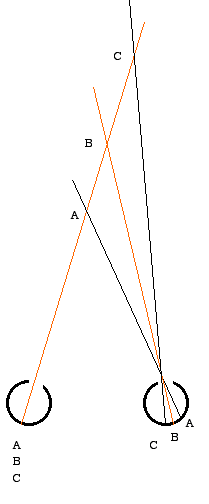 |
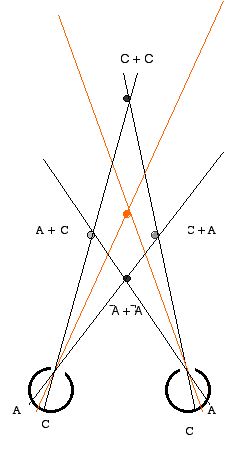 |
From the forum
We talked in class about how we only see color if our cone system is activated. I remember doing an experiment in high school biology in which an object was put in an observer's periphery vision, and the observer stated whether he saw the color first or the shape of the object first ... Lauren McD
I also found the point that colors are fully dissociable from wavelengths to be very interesting because I was always taught that a specific wavelength needed to be prevalent to see a particular color such as red ... Saba Ashraf
I always thought the way I perceived the color was correct and didn't understand why we all saw colors differently .... mcchen
how is it that, despite our inability to see every color in the exact same way as another person, we as a whole have come to recognize “blue” as blue and “red” as red, etc.? ... cschoonover
Jonathan I. (a 65-year-old artist), was in a car accident. Afterwards, Jonathan had transient amnesia, transient alexia (inability to read), and the inability to see color. This was devastating to the artist who had been known for his vibrant paintings. What was going on in his brain to cause this inability to perceive color? The phenomena occurred too quickly for it to be due to damage in the eyes, and in fact the patient reported that his “vision had become much sharper, that of an eagle.” Jonathan I. was also unable to construct color in his mind, his memories, and his dreams. He was unable to remember what color ever looked like. The patient was tested and it became clear that he could discriminate wavelengths! ... natmackow
Now I think about it, I always knew that what we perceive is a construction of the brain and there is no absolute truth in the things we see (or there is, but we wouldn’t know) ... I think I expect something more than “informed guess based on presumptions” for our brains ...yml
Maybe we’re not actually “seeing” anything but rather out brains are just filling in everything according to expectations ... Andy Mittleman
We don’t see the same thing, and to be honest, I like that. If there weren’t differences like these, life would get boring pretty fast ... Jeannette Bates
This question "if the brain imposes its own construction on perception, how much of what we actually see is real (versus "fake" or an "illusion")?" seems to be popular in this forum. However, I'm beginning to develop a distaste for the label "illusion" or "fake." I don't think any part of life, generally, is an illusion. People do have different perspectives and backgrounds that help create a range of lenses with which they can experience life. Maybe in a vacuum, we would and could see the world as it truly is (color as a physical entity). But in this world - our world - where social interaction, social construction, cultural and societal bias is nearly unavoidable, we see color because our brain wills it or constructs it ... skim
it's nice to now know that if I do not quite correctly pronounce words in foreign languages, the judge’s brains will hopefully fill in what they think I was supposed to sing ... Colette
Is the fact that we don’t easily notice when someone changes something about their appearance, like their hair or glasses, related to our reliance on mental pictures and filling in the lines? ... araeber
I do graphic design with computer sometimes, and I know there is a big difference between the color spaces on computer and in print - and the range of colors we can see is much wider than both systems ... Congwen
by asking these questions of perception and doubting our own reality, are we reaching a truer understanding? I personally doubt we could ever 'see' reality ... It is however interesting that we seem to have come to somewhat of an enlightenment by realizing these limitations, and attempting understand why they exist. If we know our vision is limited by the capacity of our rods and cones, than we can begin to imagine or create a picture of the world that is not limited thus ... dvergara
I found this interesting article Color Plays Musical Chairs In The Brain .... What this study looks at is what happens when color loses the object to which it is linked .... instead of disappearing along with the lost object, the color latches onto a region of some other object ... molivares
why do I even need this I-function? It is kind of getting in my way ... Schmeltz
Nervous system always has five ways to do the same thing - multiple depth cues
Better "picture" by making use of multiple perspectives, accepting/making use of "conflicts", picture in head a story/informed guess
3-D space and time features of story teller, not "reality"? (more than 3 dimensions in the unconscious)
Ambiguity as fundamental in seeing (Hofstadter's Road Sign), sensory systems generally
Can be reduced by using multiple cues, not eliminated (a "useful" gap?)- Picture in head could be otherwise
Ambiguity makes possible the creation of things that haven't previously been seen/conceived (impossible figures)
Lessons from color and ...
- "color" is a function of brain, not of physical reality
- Add color contrast, like brightness contrast - Serendip
- Does a tree falling in the woods make a sound if no one is there?
- perception is different in different organisms (Goldsmith, Scientific American, July 2006)
- Most vertebrates have four cone pigments
- Most mammals have two
- perception different in different people
- Color "blindness" (alternate)
- Human tetrachromacy
- what is "real"? does it matter?
- what is "normal"?, the issue of "Culture as Disability"
- multiple perspectives advantageous? generative?
- sensory info, like motor output, coded across populations
- brain creates "platonic ideals" - "categories" which "work"
- a "gap" between the "physical" and the "mental"?
- allows creation of things which don't exist in physical reality - non-spectral colors
- is all done without the I-function
- there is a difference between knowing how to do something and EXPERIENCING doing something - a "crack"? another hint about the existence of and role of the I-function?
relates to The Content and Epistemology of Phenomenal Belief, by David Chalmers, and Vision in a Complete Achromat, written by a vision scientist.
The picture in the head always an hypothesis, checked and rechecked ... ? The sky ... and the self ... and reality always an hypothesis? Where is the picture in the head, and what does all this have to do with the I-function/story teller? Could that be the doubter, the entertainer of previously unconceived alternatives? "reality" created by the story teller as a stimulus for checking?
- Disconcerting ... but also liberating?
- individual creativity
- value of interpersonal sharing
The bipartite brain: where is the picture in the head? the I-function/story teller?
Multiple ganglion cell types - frog
- contrast and color opponency
- multiple samples
- motion
Retinal projections ... another ... another
- multiple targets
- midbrain
- thalamus -> striate cortex
- different, parallel functions
... beginning to bring images together, creating a new reference frame
Moving on to neocortex
Remembering some relevant comparative neuroanatomy - neocortex as parallel to rest of nervous system
 |
 |
 |
 |
 Visual Cortex - binocular convergence, altered "feature" detection, columnar organization, topographic organization
Visual Cortex - binocular convergence, altered "feature" detection, columnar organization, topographic organization
- Picture in head not in striate cortex
- parallels to topographic organization in motor cortex
- laterality re what looking at rather than re "self"
- unlike picture in head, representation in visual cortex moves when eyes move
Multiple cortical visual areas
- Color and motion dissociable
- Partial color deficits
- motion blindness
- face blindness
- Distributed "picture in head"
Blindsight and its implications - Don't NEED "picture in head"
- What IS "picture in head" for?
- internal experience
- Self as object
- I-function ("story teller"?) in neocortex? constructed ("story"), testable, reconceivable, "imaginary" and hence re-imaginable
 Lessons from sensory side ...
Lessons from sensory side ...
- distributed systems
- ns "creative", "reality" an hypothesis rather than a touchstone?
- distinction between responding and experiencing, I-function/story teller
- picture in head = pattern of activity in neocortex, thoughts/ideas?
- I-function/story teller relates to neocortex?

From April 20 on, see notes2




